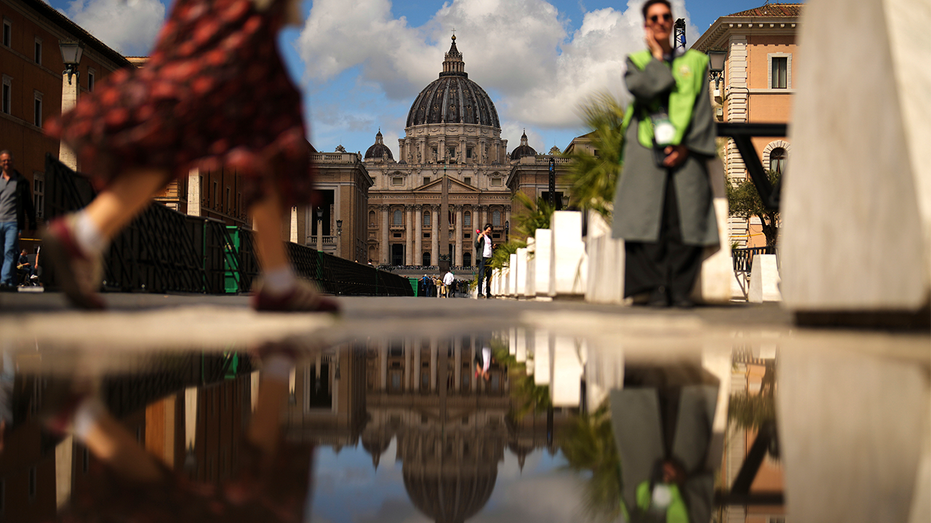In a significant event for the Catholic Church, cardinals from around the globe gathered at St. Peter’s Basilica for a solemn Mass on the eve of the papal conclave. This liturgy marked the last gathering before the election of a new pope, following the departure of Pope Francis.
The atmosphere within the storied basilica was one of reverence and anticipation. Many of the cardinals participating in the Mass had traveled from their respective dioceses and countries, their expressions reflecting a blend of solemn duty and hopeful expectation. The Mass served not only as a spiritual preparation for the upcoming conclave but also as a moment for the cardinals to unite in prayer, seeking divine guidance as they prepare to elect a new spiritual leader for over a billion Catholics worldwide.
The Mass was conducted with great solemnity and tradition, featuring readings from Scripture and prayers that reflected on the responsibilities of leadership within the Church. The homily was delivered by a senior cardinal, who emphasized the importance of unity and discernment in the pivotal process of selecting a new pope. He encouraged the attending cardinals to remain open to the Holy Spirit’s promptings as they weighed the qualities and vision needed for future papal leadership.
As the service concluded, the cardinals processed out of the sanctuary, a visual representation of the diverse global Church they represent. Each cardinal carried with them the hopes and concerns of their respective communities, reminding all present of the significant decision about to be made.
The conclave, which is set to follow this final Mass, will be a closed and confidential gathering, where the cardinals will engage in a process of deliberation and voting. Traditionally, the conclave convenes in the Sistine Chapel, a setting ripe with historical significance and artistry. The world will be watching closely, as the outcome of this conclave holds the potential to shape the future direction of the Catholic Church.
Each cardinal has been deeply encouraged to reflect on the qualities needed in a modern pope who can address the vast array of challenges facing the Church today. From issues of social justice and the environment to church governance and engagement with a diversifying global population, the new pope will face considerable expectations.
The election process itself will involve multiple ballots, requiring a two-thirds majority for a candidate to be elected. This often results in lengthy deliberations, as cardinals discuss various candidates, each bringing their perspectives and insights into the discussions.
The anticipated symbol of white smoke rising from the chimney of the Sistine Chapel will signal the triumphant selection of a new pope. Until then, the air is thick with speculation about potential contenders and the directions they might take the Church. Among the names mentioned are those of cardinals with varied backgrounds, ranging from those with strong pastoral experience to others well-versed in theological scholarship.
In the lead-up to the conclave, analysts and observers ponder the challenges and opportunities that accompany the election of a new pope. These considerations extend beyond merely administrative and doctrinal concerns; the new pontiff’s ability to communicate effectively with a global audience is increasingly crucial. In an age characterized by rapid technological change and heightened interconnectedness, the future pope will need to leverage multiple forms of communication to reach people effectively.
As the clock counts down to the conclave, the pastoral nature of the cardinals’ mission shines through. They are aware that their choice will have lasting implications not only for the Catholic faith but also for social issues around the globe. The Church has a vital role in advocating for solidarity, peace, and compassion, and the leaders chosen during the conclave will be pivotal in steering these efforts.
Furthermore, the desire for renewal and revitalization within the Church remains an ever-present theme within this gathering. Many faithful observers and theologians express hope that the conclave will result in a leader who embodies a spirit of reform while maintaining the essential teachings of the Church. As part of this reflective journey, the cardinals are also keenly aware of their duty to represent the voices of various laypeople and communities that might feel marginalized in contemporary Church discourse.
The extensive reach of the Catholic Church further amplifies the significance of this conclave. With its members residing in various cultures and societies, the task of choosing a pope becomes an exercise in navigating wide-ranging attitudes and needs. This diversity makes the prospect of selecting a leader who can engage with local issues while maintaining global cohesion particularly challenging yet crucial.
The concluding Mass at St. Peter’s Basilica has provided the cardinals with a reflective respite before stepping into their historic duty. Attendees witnessed not only the powerful prayer life of the Church but also the solidarity among its leaders during this significant moment.
As the first ballots are cast and the conclave begins, the anticipation builds, marking a new chapter in Catholic history. Those who have made the pilgrimage to the Vatican not only as a sign of respect for the traditions of their faith but also as a testimony to their hope for the future of the Church await the announcement of the new Pope with bated breath.
This transitional phase is a call for all Catholics to pray for wisdom and grace as their leaders navigate these sacred decisions. The new pontiff, when chosen, will undoubtedly be charged with addressing the manifold opportunities and challenges that await the Catholic Church in the 21st century.
The world remains eager to witness the next steps in this remarkable journey full of significance, as the cardinals strive to fulfill their sacred responsibilities and advance the mission of the Catholic Church through the conclusion of the conclave and beyond.
































